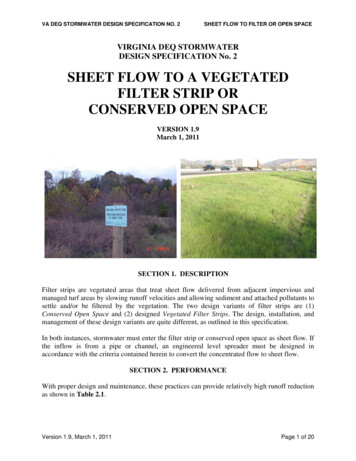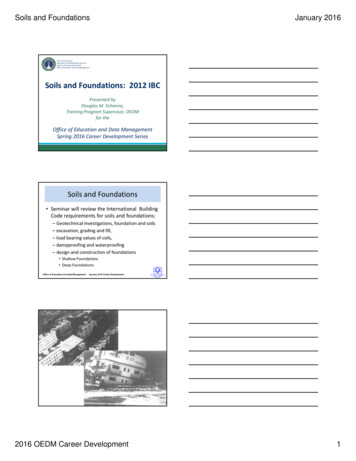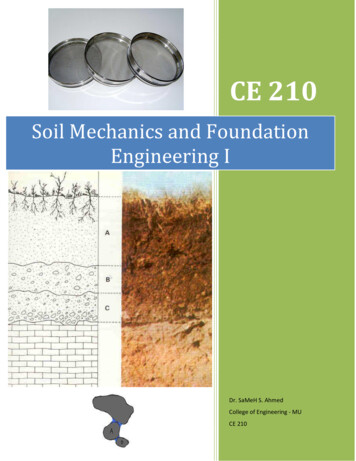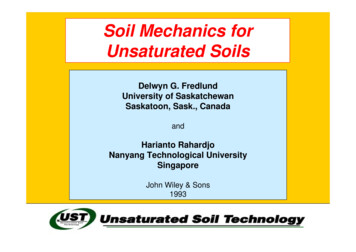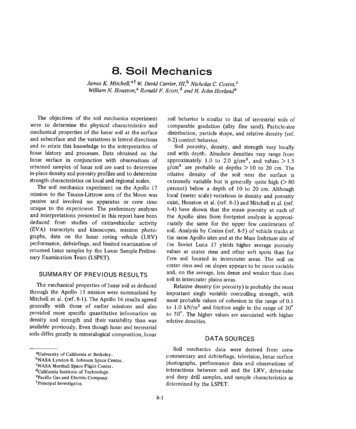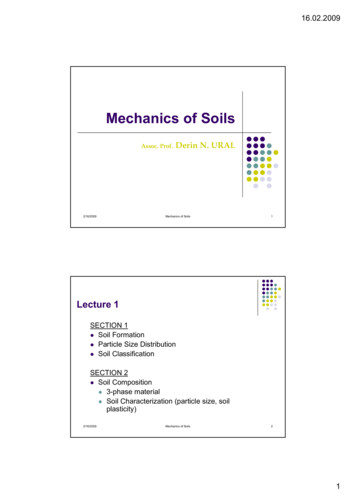
Transcription
16.02.2009Mechanics of SoilsAssoc. Prof.2/16/2009Derin N. URALMechanics of Soils1Lecture 1SECTION 1z Soil Formationz Particle Size Distributionz Soil ClassificationSECTION 2z Soil Compositionz 3-phase materialz Soil Characterization (particle size, soilplasticity)2/16/2009Mechanics of Soils21
16.02.2009Soil MechanicszSoil mechanics is the branch of science that deals withthe study of physical properties of soil and the behaviorof soil masses subjected to various types of forces.zzzz2/16/2009Classify soils and rocksEstablish engineering propertiesAscertain the compressibilityAscertain the shear strengthMechanics of Soils3According to Terzaghi (1948):“Soil Mechanics is the application of laws ofmechanics and hydraulics to engineering problemsdealing with sediments and other unconsolidatedaccumulations of solid particles produced by themechanical and chemical disintegration of rocksregardless of whether or not they contain anadmixture of organic constituent.”2/16/2009Mechanics of Soils42
16.02.2009Soil FormationParent RockResidual soilTransported soil in situ weathering (byphysical & chemicalagents) of parent rockeathered and weatheredtransported far awayby wind, water and ice.2/16/2009Mechanics of Soils5Soil Formation formed by one of these three different processesigneousformed byy coolingg ofmolten magma (lava)e.g., granitesedimentaryformed by gradualdeposition, and in layerse.g., limestone, shalemetamorphicformed by alterationof igneous &sedimentary rocks bypressure/temperaturee.g., marble3
16.02.2009Determination of Particle SizeDistributionzMechanical analysis is used in the determination of thesize range of particles present in a soilsoil, expressed as apercentage of the total dry weight.zThere are two methods that generally utilized todetermine the particle size distribution of soil:zz2/16/2009Sieve Analysis(for particle sizes 0.075mm in diameter)Hydrometer Analysis ( “““ 0.075mm “ “)Mechanics of Soils7Particle Size Distributions and SoilParticle CharacteristicszParticle size distribution curve is a representation in graphical ortabular form of the various (diameter) grain sizes in a soil,determined through sieving and sedimentation.zThe particle diameters are plotted in log scale, and thecorresponding percent finer in arithmetic scale.2/16/2009Mechanics of Soils84
16.02.2009Particle Size Distribution CurveSILT & CLAY2/16/2009SANDMechanics of SoilsGRAVEL9Sieve AnalysiszIt is performed by shakingthe soil sample through aset of sieves havingprogressively smalleropenings.2/16/2009Mechanics of Soils105
16.02.2009Hydrometer AnalysiszIt is based on the principle of sedimentation of soil grainsin water.By David Airey, The University of Sydney2/16/2009Mechanics of Soils11Hydrometer Analysis Also called SedimentationAnalysis Stoke’s LawD 2γ w (Gs GL )v 18η2/16/2009Mechanics of Soils126
16.02.2009Some commonly used measures are:a)Effective size : (D10)It is the diameter in the particle size distribution curvecorresponding to 10% finer. (maximum size of the smallest 10%of the soil)b)Uniformity Coefficient:Cu D60 / D10It is the ratio of the maximum diameter of the smallest 60% tothe effective size.size 2/16/2009A well graded soil will haveCu 4 for gravelsCu 6 for sandsMechanics of Soils13Some commonly used measures are:c)Coefficient of Curvature:C c (D 30) 2 / (D 60 * D10)D30: Diameter corresponding the 30% finerd)2/16/2009Clay Fraction: (CF)It is the percentage by dry mass of particles smaller than0.002mm (2μm), and is an index property frequently quotedrelation to fine grained soils (soils with 50% or more finer than63μm). It has a strong influence on the engineering propertiesof fine grained soils.Mechanics of Soils147
16.02.2009Definitionse)Well-Graded Material – Contains particles of a wide range ofsizes The smaller particles fill the spaces left between the largersizes.particles; therefore the soil has greater strength than a poorlygraded soil, and lower permeability.f)Poorly – Graded Material – Contains a large portion of uniformlysized particles. This particular soil has larger voids in its structureand poor strength along with high permeabilitypermeability.2/16/2009Mechanics of SoilsBy David Airey, The University of SydneySoil A: Well GradedSoil B: Poorly GradedSoil C: Uniform2/16/200915Mechanics of Soils168
16.02.2009Soil Plasticity & Consistency LimitszIn the early 1900s a Swedish scientist “Atterberg” developed amethod to describe the consistency of fine grained soils withvarying degree of moisture content.contentzIf a soil is gradually dried from a slurry, it passes from state ofviscous liquid to a plastic state; then to a semi-solid, and finally intoa solid state. The moisture contents at which the soil passes fromone state to the next are known as consistency limits (also called“Atterberg Limits”)zConsistency limits are utilized to compare soils from differentlocations and different depths.zThere are 4 basic states2/16/2009Mechanics of Soils17Atterberg Limits Consistency of fine-grained soil varies in proportion to the water contentliquidLiquid limitPlasticityIndexplastic(pea soup)(peanut butter)Plastic limitsemi-solidShrinkage limitsolid(cheese)(hard candy)By P. Jayawickrama, Texas Tech University2/16/2009Mechanics of Soils189
16.02.2009VolumeConsistency Moisture Content (%)2/16/2009Mechanics of Soils19Definitionsa)Liquid Limit (LL) : is the minimum moisture content at which thesoil will flow under its own weight. The moisture content (in %)required to close a distance of 1212.7mm7mm along the bottom of thegroove after 25 blows is thell.b)Plastic Limit (PL): is the moisture content (in %) at which the soilwhen rolled into threads of 3.2mm in diameter, crumbles. PL isthe lower limit of the plastic stage of the soil. The test is simpleand performed by repeated rollings of ellipsoidal size soil mass byhand on a ground glass plateplate.c)Shrinkage Limit (SL): is the moisture content (in %) at which thevolume change of the soil mass ceases.2/16/2009Mechanics of Soils2010
16.02.2009DefinitionsPlasticity Index (PI): is a measure of the range of the moisturecontents over which a soil is plastic.d)PI LL- PLLiquidity Index (LI): The relative consistency of a cohesive soilin a natural state can be defined by the ratio called LI.e)LI (w - PL) / (LL- PL)Activity : is the ratio off PI to the clay fractionf(% by dry weight offparticles 2μm)f)A PI / (Clay fraction%)2/16/2009Mechanics of Soils21CLASSIFICATION OF SOILSzThe sizes of particles that make up soil may vary widelydepending on the predominant size of particlesparticles. Soils areclassified as :1)2)3)4)zGravelSandSiltClayThe most comprehensive is the Unified Soil ClassificationSystem (USCS).2/16/2009Mechanics of Soils2211
16.02.2009USCSzThis system classifies soils under two broadcategories:zCoarse Grained Soils -are gravelly and sandy innature with 50% passing through a #200 sieve(diameter 0.075mm) zG :“Gravel”S : “Sand”Fine Grained Soils: have 50% or more passingthrough the #200 sieve. M: inorganic SiltC: inorganic Clay2/16/2009O: Organic Silts and ClaysPt: Peat, muck, highly organic soilsMechanics of Soils23USCSzThe standard system used worldwide for most majorconstruction projects is known as the Unified SoilClassification System (USCS).zThis is based on an original system devised byCassagrande. Soils are identified by symbols determinedfromzz2/16/2009Sieve analysis andAtterberg Limit tests.Mechanics of Soils2412
16.02.2009USCS TableUnified soil classification (including identification and description)GMPlastic fines (for identification procedures see CL below)Give typical names: indicate approximate percentages of sandand gravel: maximum size:angularity, surface condition,and hardness of the coarsegrains: local or geological nameand other pertinent descriptiveinformation and symbol inparentheses.GCClayey gravels, poorly gradedgravel-sand-clay mixturesWide range in grain sizes and substantial amounts of all intermediateparticle sizesSWWell graded sands, gravellysands, little or no finesFor undisturbed soils add information on stratification, degreeof compactness, cementation,moisture conditions and drainage characteristics.Predominantely one size or a range ofsizes with some intermediate sizes missingSPPoorly graded sands, gravellysands, little or no finesNon-plastic fines (for identification procedures, see ML below)SMSilty sands, poorly gradedsand-silt mixturesPlastic fines (for identification procedures, see CL below)SCClayey sands, poorly gradedsand-clay mixturesGPExample:Silty sand, gravelly; about 20%hard angular gravel particles12.5mm maximum size; roundedand subangular sand grainscoarse to fine, about 15% nonplastic lines with low drystrength; well compacted andmoist in places; alluvial sand;(SM)and claysSilts aliquuid limitless than 50Highly organic soilsSlight tomediumSlow tononeSlight tomediumMHHigh to veryhighNoneHighCHInorganic silts and very fine sands,sandsrock flour, silty or clayeyfine sands with slight plasticityInorganic clays of low to mediumplasticity, gravelly clays, sandyclays, silty clays, lean claysOrganic silts and organic siltclays of low plasticityinorganic silts, micaceous ordictomaceous fine sandy orsilty soils, elastic siltsInorganic clays of highplasticity, fat claysMedium tohighNone to veryhighSlight tomediumOHOrganic clays of medium tohigh plasticityPtPeat and other highly organic soilsNone toslightQuick toslowNoneMLMedium tohighNone to veryslowMediumCL,CISlight tomediumSlowSlightOLReadily identified by colour, odourspongy feel and frequently by fibroustexture2/16/2009Give typicalGii l name; indicatei diddegreeand character of plasticity,amount and maximum size ofcoarse grains: colour in wet condition, odour if any, local orgeological name, and other pertinent descriptive information, andsymbol in parenthesesExampleClayey silt, brown: slightly plastic:small percentage of fine sand:numerous vertical root holes: firmand dry in places; loess; (ML)Laboratory classificationcriteriaDetermine percentages of gravel and sand from grain sizee curveDepending on percentages of fines (fraction smaller than .075mmsieve size) coarse grained soils are classified as followsLess than 5%GW, GP, SW, SPMore than 12% GM, GC, SM, SC5% to 12%Bordeline case requiring use of dual syymbolsNon-plastic fines (for identificationprocedures see ML below)Information required fordescribing soilsTypical namesWell graded gravels, gravelsand mixtures, little or nofinesPoorly graded gravels, gravelsand mixtures, little or nofinesSilty gravels, poorlygraded gravel-sand-silt mixturesUse grain sizee curve in identifying the fractions as given under field identificationGravels with Clean ggravelsfines(little or no(apreciablefinees)amount of fines)Clean sands(little or nofines)Sands withfines(appreciableamount of fines)GravelsMore than half of coarssefraction is larger than2.36mmSandsMore than half of coarsefraction is smaller than2.36mmGWIdentification procedure on fraction smaller than .425mmsieve sizeDry ctioncharacterplasticto shaking) nearisticslimit)Silts and claysliquid limitgreater than50Coarse grained soilsFine grained soilsaller thanMore than half of material is larger thanMore than half of material is sma.075mm sieve size.075mm sieve sizeThe .075mm sieve size is about the smallest particle visible to the naked eyeWide range of grain size and substantialamounts of all intermediate particlesizesPredominantly one size or a range ofsizes with some intermediate sizesmissingFor undisturbed soils add information on structure, stratification, consistency and undisturbed and remoulded states,moisture and drainage conditionsDC U ---- 60 Greater than 4D 102(D )--------- Between 1 and 3C c ------------30D10 x D60Not meeting all gradation requirements for GWAbove "A" line withPI between 4 and 7are borderline casesAtterberg limits above "A" requiring use of dualline with PI greater than 7 symbolsAtterberg limits below"A" line or PI less than 4DC U --- 60 Greater than 6D 10(D )2---------- Between 1 and 3C c -----------30D 10 x D60Not meeting all gradation requirements for SWAbove "A" line withPI between 4 and 7are borderline casesAtterberg limits above "A" requiring use of dualline with PI greater than 7 symbolsAtterberg limits below"A" line or PI less than 460Comparing soils at equal liquid limitToughness and dry strength increase50" li"Awith increasing plasticity indexPlasticity indexGroupsymbols1Field identification procedures(Excluding particles larger than 75mm and basing fractions onestimated 0 50 60Liquid limit708090100Plasticity chartfor laboratory classification of fine grained soilsMechanics of Soils25Classification ProcedurezCoarse Grained MaterialszzIf more than half of the material is coarser than the 75 μmmsieve, the soil is classified as coarse. The following stepsare then followed to determine the appropriate 2 lettersymbolDetermine the1st letter of the symbol zDetermine the 2nd letter of symbol 2/16/2009If more than half of the coarse fraction is sand then use prefixSIf more than half of the coarse fraction is gravel then use prefixGThis depends on the uniformity coefficient Cu and thecoefficient of curvature Cc obtained from the grading curve, onthe percentage of fines, and the type of fines.Mechanics of Soils2613
16.02.2009Classification ProcedurezzFirst determine the percentage of fines, that is the % of materialpassing the 75 μm sieve.Then if % fines iszzzzzz 5% use W or P as suffix 12% use M or C as suffixbetween 5% and 12% use dual symbols. Use the prefix from abovewith first one of W or P and then with one of M or C.If W or P are required for the suffix then Cu and Cc must beevaluatedIf prefix is G then suffix isotherwise useIf prefix is S then suffix isotherwise use2/16/2009W if Cu 4 and Cc is between 1 & 3PW if Cu 6 and Cc is between 1 & 3PMechanics of Soils27Classification ProcedurezIf M or C are required they have to be determined fromthe pprocedure used for fine ggrained materials discussedbelow. Note that M stands for Silt and C for Clay. This isdetermined from whether the soil lies above or below theA-line in the plasticity chart.zFor a coarse grained soil which is predominantly sandthe following symbols are possiblezSW, SP, SM, SCzSW-SM, SW-SC, SP-SM, SP-SC2/16/2009Mechanics of Soils2814
16.02.2009Classification ProcedurezThese are classified solely according to the results fromthe Atterberg Limit TestsTests. Values of the Plasticity Indexand Liquid Limit are used to determine a point in theplasticity chart. The classification symbol is determinedfrom the region of the chart in which the point lies.Examplesz CHz CLz MHz MLz OHz PtHigh plasticity clayLow plasticity clayHi h plasticityHighl ti it siltiltLow plasticity siltHigh plasticity organic soil (Rare)Peat2/16/2009Mechanics of Soils29Casagrande Plasticity Chart60Comparing soils at equal liquid limit50Toughnesshandd dryd strengthtth increaseiein"l"APlasticity indexwith increasing plasticity index40CH30OH20CL2/16/200910CL0ML10 20orOLOor0MHML3040 50 60Liquid limitMechanics of Soils708090 1003015
16.02.20093-Phase MaterialAirW tWaterSolidBy P. Jayawickrama, Texas Tech University2/16/2009Mechanics of Soils31The Mineral SkeletonSolid ParticlesVolumeVoids ((air or water))2/16/2009Mechanics of Soils3216
16.02.2009Three Phase DiagramAirWaterS lidSolidIdealization:Three Phase DiagramMineral Skeleton2/16/2009Mechanics of Soils33Fully Saturated SoilsWaterSolidMineral Skeleton2/16/2009Fully SaturatedMechanics of Soils3417
16.02.2009Dry SoilsAirSolidDry SoilMineral Skeleton2/16/2009Mechanics of Soils35Partly Saturated SoilsAiAirWaterS lidSolidMineral Skeleton2/16/2009Partly Saturated SoilsMechanics of Soils3618
16.02.2009Phase DiagramVaAiAirWa hanics of Soils37Objectives of a Phase DiagramTo compute the weights (or masses) and volumes ofthe three different phases.NotationM mass or weightV volumes soil grainsw watera airv voidst totalVvVaAirVwWaterWa 0WwWtVtVsSolidWsPhase Diagram3819
16.02.2009Volume RelationshipsVoid ratio (e): is a measure of the void volume.VvVe VVSVaAirVwWaterWa 0WwVtVsS lidSolidWtWsPhase Diagram2/16/2009Mechanics of Soils39Volume RelationshipsPorosity (n): is also a measure of the void volume,expressed as a percentage.Vn VVTVvX 100%VaAirVwWaterWa 0WwWtVtVsTheoretical range: 0 – 100%SolidWsPhase Diagram2/16/2009Mechanics of Soils4020
16.02.2009Volume RelationshipsDegree of saturation (S): is the percentage of the voidvolume filled by water.S VWVVVvX 100%AirVwWaterWa 0WwWtVtRRange:0 – 100%DryVaVsSolidWsSaturated2/16/2009Phase DiagramMechanics of Soils41Weight RelationshipsWater content (w): is a measure of the waterpresent in the soil.Ww WWSVvX 100%VaAirVwWaterWa 00WwWtVtExpressed as percentage.percentageVsRange 0 – 100%.SolidWsPhase Diagram2/16/2009Mechanics of Soils4221
16.02.2009Unit Weight RelationshipsNatural Unit Weight (γ): is thedensity of the soil in thecurrent state.γ WTVTVvAirWa 0VwWaterWwVsSolidVtDry Unit Weight (γd): is the unitweight of the soil in dry state.γd VaWSVT2/16/2009WtWsPhase DiagramMechanics of Soils43Unit Weight RelationshipsSaturated Unit Weight (γsat): is theunit weight of the soil when thevoids are filled with waterwater.VvWs Vv * γwγsat VTAirWa 00VwWaterWwVsSolidWsVtSubmerged Unit Weight (γsub): isthe effective unit weight of the soilwhen it is submerged.submergedγsub γsat γw2/16/2009VaWtPhase DiagramMechanics of Soils4422
16.02.2009Phase RelationsConsider a fraction of the soil where Vs 1.The other volumes canbe obtained from theprevious definitions.AireSeWaterSeγw1SolidGsγwThe weights can beobtained from:Weights Unit Weights x VolumevolumesweightsPhase DiagramPhase RelationsFrom the previous definitions,w WW Se WS GSAireVen V VT 1 eSeWaterSeγw1SolidGsγwvolumes2/16/2009Mechanics of SoilsweightsPhase Diagram4623
16.02.2009Phase Relationsγ γ satWT GS Se γWVT1 eAireG eWγW T SVT1 eγd WSG S γWVT 1 se DiagramMechanics of Soils47DefinitionsBulk (natural), saturated, dry and submergeddensities (ρ) are defined in a similar manner.Here, you can also use mass (kg) instead of weight (kN).γ / g ρ M/VN/m32/16/2009m/s2Mechanics of Soilskg/m34824
16.02.2009Specific GravityGS GS zWeight of a Subs tan ceWeightg off an EqualqVolume off WaterUnit Weight of a Subs tan ceUnit Weight of WaterUnit weight of WaterWater, γwzzγw 1.0 g/cm3 (strictly accurate at 4 C)γw 9.81 kN/m32/16/2009Mechanics of Soils49In Terms of Densityi.Density of water :ρw 1000kg/m3ii.Dry density of soil :ρd iii.Bulk density of unsaturated or saturated soil:iv.Air content (A) :2/16/2009A MSG S ρWVT1 eρ M T GS Se ρWVT1 eVa e GS w VT1 eMechanics of Soils5025
16.02.2009Relationship between parameterszThese definitions can be used to determine any desiredrelationships between above quantitiesquantities, and hence todetermine void ratio, degree of saturation, etc. That cannot be measured directly by laboratory tests. Somerelationships are as follows:2/16/2009Mechanics of Soils51Relationship between parameterszFor unsaturated soils:w WW Se WS GSe For saturated soils: S 1 then;zBulk density;ρ M T GS Se ρWVT1 ezDry density;ρd MSG S ρWVT1 ezDegree of Saturation;2/16/2009[1]e GS wzS GS wSρ G ( w 1) ρw(GS w GS )ρw S1 e1 eρ d (1 w) ρGS wρ(1 w)GS ρw ρMechanics of Soils5226
16.02.2009By N. SivakuganzzzzTry not to memorize the equations. Understandthe definitions, and develop the relations from thephase diagram with VS 1;Assume GS ((2.6-2.8)) when not ggiven;;Do not mix densities and unit weights;Soil grains are incompressible. Their mass andvolume remain the same at any void ratio.2/16/2009Mechanics of Soils532/16/2009Mechanics of Soils5427
16.02.20092/16/2009Mechanics of Soils5528
16.02.2009 2 Soil Mechanics zSoil mechanics is the branch of science that deals with the study of physical properties of soil and the behaviorthe study of physical properties of soil and the behavior of s

